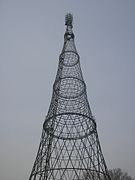|
Shukhov Tower
55°43′02″N 37°36′41″E / 55.71722°N 37.61139°E
The Shukhov Radio Tower (Russian: Шуховская башня), also known as the Shabolovka Tower (Шаболовская башня), is a broadcasting tower deriving from the Russian avant-garde in Moscow designed by Vladimir Shukhov. The 160-metre-high (520 ft) free-standing steel diagrid structure was built between 1920 and 1922, during the Russian Civil War. History DesignVladimir Shukhov invented the world's first hyperboloid structure in the year 1890. Later he wrote a book, Rafters, in which he proved that the triangular shapes are 20-25% heavier than the arched ones with a ray grating. After that, Shukhov filed a number of patents for a diagrid. He aimed not only to achieve greater strength and rigidity of the structure, but also ease and simplicity through the use of as little building material as possible. The first diagrid tower was built for the All-Russia Exhibition in Nizhny Novgorod in 1896, and later was bought by Yury Nechaev-Maltsov, a well-known manufacturer in the city. Shukhov was responsible for constructions of a new types of lighthouses, masts, water towers and transmission towers. The broadcasting tower at Shabolovka is a diagrid structure in the form of a rotated hyperboloid. The Khodynka radio station, built in 1914, could no longer handle the increasing amount of radiograms. On July 30, 1919, Vladimir Lenin signed a decree of the Council of Workers' and Peasants' Defense, which demanded "to install in an extremely urgent manner a radio station equipped with the most advanced and powerful devices and machines", to ensure the security of the country and allow constant communication with other republics. Tower designing was started immediately across many bureaus. Later that year Shukhov's Construction Office won a competition. The planned height of the new nine-sectioned hyperbolic tower was 350 metres (1,150 ft) (15 metres (49 ft) taller than the Eiffel Tower, which was taken into consideration when creating the plan) with an estimated mass of 2,200 tons (the Eiffel Tower weighs 7,300 tons). However, in the context of the Civil War and the lack of resources, the project had to be revised: the height was reduced to 148.5 metres (487 ft), the weight to 240 tons.[1] InstallationTower construction was carried out without any cranes and scaffolding, but only with winches. 240 tons of metal that was required for construction, was allocated by Lenin’s personal decree from the stocks of the Military Department. For lifting five wooden winches were used, which were moved to the upper sections. The tower is composed of six sections, one above the other. Each section is an independent hyperboloid based on a larger one. The sixth section was installed and finally secured on February 14, 1922. StructureThe Shukhov tower is a hyperboloid structure (hyperbolic steel gridshell) consisting of a series of hyperboloid sections stacked on one another to approximate an overall conical shape. The tower has a diagrid structure, and its steel shell experiences minimum wind load (a significant design factor for high-rising buildings). The tower sections are single-cavity hyperboloids of rotation made of straight beams, the ends of which rest against circular foundations. LocationThe tower is located a few kilometres south of the Moscow Kremlin, but is not accessible to tourists. The street address of the tower is "Shabolovka Street, 37". Possible demolitionAs of early 2014, the tower faced demolition by the Russian State Committee for Television and Radio Broadcasting, after having been allowed to deteriorate for years despite popular calls for its restoration.[2] Following a concerted campaign calling for the preservation of the tower, on July 3 the Ministry of Culture of Russia announced that the tower will not be demolished,[3] and in September 2014 that Moscow City Council had placed a preservation order on the tower in order to safeguard it.[4][5] In January 2017 the RTRS placed a request for tender for a plan to renovate and preserve the monument.[6] ModelsThere is a model of Shukhov's Shabolovka Tower at the Information Age gallery at the Science Museum in London. The model is at 1:30 scale and was installed in October 2014.[7] In popular culture
Gallery
See also
References
Literature
(in German)
(in French)
External linksWikimedia Commons has media related to Shukhov tower.
(in Chinese) |
||||||||||||||||||||||||||







